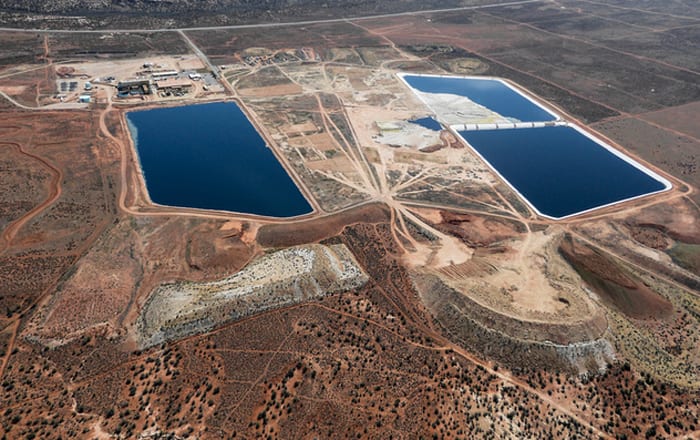 |
| Photo: Ecoflight |
Grand Canyon Trust
New data reveals that emissions of radon – a radioactive, invisible, odorless, cancer-causing gas – from the White Mesa Uranium Mill exceed Clean Air Act (CAA) standards by over 50 times the legal limit. Using an Environmental Protection Agency (EPA) formula, Uranium Watch and the Grand Canyon Trust calculated radon-222 emissions of over 1,000 pico Curies per square meter per second (pCi/m2-sec) from Cell 1, one of the mill’s liquid-covered waste impoundments. In a separate calculation, the Ute Mountain Ute Tribal Environmental Department also found radon-222 emissions at over 1,000 pCi/m2-sec from Cell 1. The legal limit for radon-222 emissions from Cell 1 is 20 pCi/m2-sec.
According to Sarah Fields, Program Director of Uranium Watch: “For decades the EPA claimed that the radon emissions from radium-laden liquid impoundments at uranium mills were ‘zero,’ so did not need to be determined or controlled. EPA assumed that liquids on top of solid tailings reduced radon emissions. We now know that radon emissions from liquid covers and solution impoundments are significant and must be monitored and controlled under CAA hazardous air pollution standards.”
Threatening an 80-kilometer radius
EPA has determined that radon-222 emissions in violation of the 20 pCi/m2-sec standard threaten public and environmental health within an 80-kilometer [approximately 50 mile] radius from the emission source – a distance that includes White Mesa, Blanding, Bluff, and Monticello, Utah. The mill is located just three miles from the Ute Mountain Ute tribe’s White Mesa community, on Highway 191 between Bluff and Blanding.
“Particularly given the mill’s vicinity to our White Mesa Community, we are very concerned about the difference between the high levels of radon-222 emissions calculated by our environmental department and the low levels assumed by regulators,” says Manuel Heart, Tribal Chairman from the Ute Mountain Ute Tribe. “The Ute Mountain Ute Tribe is hopeful that it can work with the regulatory agencies and the State of Utah to resolve this issue, but first we need to understand the actual level of radon-222 emissions from Cell 1.”
Regulatory agencies stalling
Despite being informed of the data in early February, neither EPA nor the Utah Department of Environmental Quality (DEQ) have formally responded to the Grand Canyon Trust and Uranium Watch’s concerns, nor have the regulators taken any enforcement action to protect public health from the radon emissions released from the White Mesa Mill liquid wastes.
“We consider this a potential public health emergency and are alarmed and disappointed by EPA’s refusal to – at minimum – disprove our respective calculations,” says Anne Mariah Tapp, Energy Program Director for the Grand Canyon Trust, “Instead of taking immediate action, EPA continues to stall while public health hangs in question.”
Serious public health concerns
Radon emissions from uranium mining and milling on and near tribal lands has been a long-recognized problem, with most attention paid to cases originating on the Navajo Nation. Currently, the Navajo Birth Cohort Study is focused on determining whether exposure to uranium mining and milling waste affects the outcome of pregnancies or the development of children. Previous studies conducted by the Centers for Disease Control have linked radioactive radon gas and the radon “daughters” produced by the decay of radon-222 to higher rates of lung cancer in uranium miners.
The White Mesa Mill is the only operating conventional uranium mill in the United States and processes both uranium mined from the Four Corners region and radioactive waste from the clean-up of toxic waste sites across North America. Cell 1 at the mill has been operating since 1981, despite a single-layer PVC liner that did not meet best available technology standards when it was installed. The Ute Mountain Ute Tribe has raised concerns about catastrophic liver failure, and there are currently documented plumes of groundwater contamination beneath the mill site. The Grand Canyon Trust is seeking to address the White Mesa Mill’s exceedance of radon emission standards and reclamation requirements by filing a citizen enforcement suit in federal district court in 2014 for CAA violations.
Seemingly oblivious to community concerns and violations of federal law, state and federal regulators continue to allow the White Mesa Mill to accept and process both conventional uranium ore and uranium-bearing toxic waste – most recently approving shipments from the Midnite Mine Superfund Site on the Spokane Indian Reservation in Washington State.
About Grand Canyon Trust:
The mission of the Grand Canyon Trust is to protect and restore the Colorado Plateau — its spectacular landscapes, flowing rivers, clean air, diversity of plants and animals, and areas of beauty and solitude.
For more information, visit http://www.grandcanyontrust.org/.




